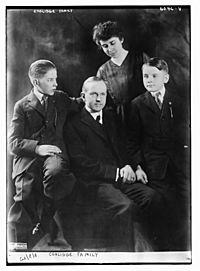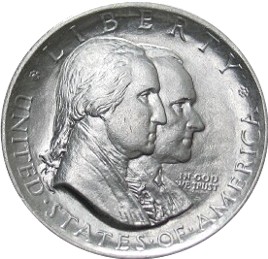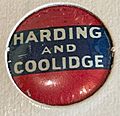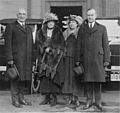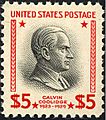Calvin Coolidge facts for kids
Quick facts for kids
Calvin Coolidge
|
|
|---|---|
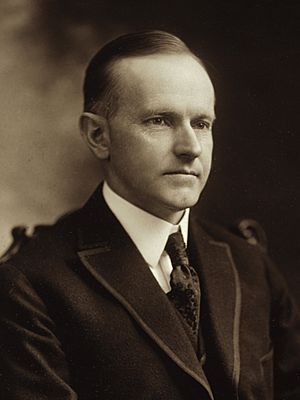
Coolidge in 1919
|
|
| 30th President of the United States | |
| In office August 2, 1923 – March 4, 1929 |
|
| Vice President |
|
| Preceded by | Warren G. Harding |
| Succeeded by | Herbert Hoover |
| 29th Vice President of the United States | |
| In office March 4, 1921 – August 2, 1923 |
|
| President | Warren G. Harding |
| Preceded by | Thomas R. Marshall |
| Succeeded by | Charles G. Dawes |
| 48th Governor of Massachusetts | |
| In office January 2, 1919 – January 6, 1921 |
|
| Lieutenant | Channing H. Cox |
| Preceded by | Samuel W. McCall |
| Succeeded by | Channing H. Cox |
| 46th Lieutenant Governor of Massachusetts | |
| In office January 6, 1916 – January 2, 1919 |
|
| Governor | Samuel W. McCall |
| Preceded by | Grafton D. Cushing |
| Succeeded by | Channing H. Cox |
| President of the Massachusetts Senate | |
| In office January 7, 1914 – January 6, 1915 |
|
| Preceded by | Levi H. Greenwood |
| Succeeded by | Henry Gordon Wells |
| Member of the Massachusetts Senate | |
| In office January 3, 1912 – January 6, 1915 |
|
| Preceded by | Allen T. Treadway |
| Succeeded by | John B. Hull |
| Constituency | Berkshire, Hampden, and Hampshire counties |
| 16th Mayor of Northampton | |
| In office January 3, 1910 – January 1, 1912 |
|
| Preceded by | James W. O'Brien |
| Succeeded by | William Feiker |
| Member of the Massachusetts House of Representatives from the 1st Hampshire district |
|
| In office January 2, 1907 – January 6, 1909 |
|
| Preceded by | Moses M. Bassett |
| Succeeded by | Charles A. Montgomery |
| Personal details | |
| Born |
John Calvin Coolidge Jr.
July 4, 1872 Plymouth Notch, Vermont, U.S. |
| Died | January 5, 1933 (aged 60) Northampton, Massachusetts, U.S. |
| Resting place | Plymouth Notch Cemetery |
| Political party | Republican |
| Spouse | |
| Children | 2, including John |
| Parent |
|
| Relatives |
|
| Education | Amherst College (AB) |
| Occupation |
|
| Signature |  |
Calvin Coolidge (born John Calvin Coolidge Jr.; July 4, 1872 – January 5, 1933) was an American attorney and politician who served as the 30th president of the United States from 1923 to 1929.
Contents
Early life
John Calvin Coolidge was born on July 4, 1872, in Plymouth Notch, Vermont—the only U.S. president to be born on Independence Day. He was the elder of the two children of John Calvin Coolidge Sr. (1845–1926) and Victoria Josephine Moor (1846–1885). Although named for his father, from early childhood Coolidge was addressed by his middle name. The name Calvin was used in multiple generations of the Coolidge family, apparently selected in honor of John Calvin, the Protestant Reformer.
Coolidge Senior engaged in many occupations and developed a statewide reputation as a prosperous farmer, storekeeper, and public servant. He held various local offices, including justice of the peace and tax collector and served in both houses of the Vermont General Assembly. When Coolidge was 12 years old, his chronically ill mother died at the age of 39, perhaps from tuberculosis. His younger sister, Abigail Grace Coolidge (1875–1890), died at the age of 15, probably of appendicitis, when Coolidge was 18. Coolidge's father married a Plymouth schoolteacher in 1891, and lived to the age of 80.
Early career and marriage
Coolidge attended the Black River Academy and then St. Johnsbury Academy before enrolling at Amherst College, where he distinguished himself in the debating class. As a senior, he joined the Phi Gamma Delta fraternity and graduated cum laude.
At his father's urging after graduation, Coolidge moved to Northampton, Massachusetts, to become a lawyer. Coolidge followed the common practice of apprenticing with a local law firm, Hammond & Field, and reading law with them. In 1897, Coolidge was admitted to the Massachusetts bar, becoming a country lawyer. With his savings and a small inheritance from his grandfather, Coolidge opened his own law office in Northampton in 1898. He practiced commercial law, believing that he served his clients best by staying out of court. As his reputation as a hard-working and diligent attorney grew, local banks and other businesses began to retain his services.
In 1903, Coolidge met Grace Goodhue, a graduate of the University of Vermont and a teacher at Northampton's Clarke School for the Deaf. They married on October 4, 1905. The Coolidges had two sons: John (1906–2000) and Calvin Jr. (1908–1924). On June 30, 1924, Calvin Jr. had played tennis with his brother on the White House tennis courts without putting on socks and developed a blister on one of his toes. The blister subsequently degenerated into sepsis. Calvin Jr. died a little over a week later at the age of 16. The President never forgave himself for Calvin Jr's death.
In 1896, Coolidge campaigned for Republican presidential candidate William McKinley, and was selected to be a member of the Republican City Committee the next year. In 1898, he won election to the City Council of Northampton, placing second in a ward where the top three candidates were elected. The position offered no salary but provided Coolidge with valuable political experience. Coolidge climbed the ladder of Massachusetts politics, becoming the state's 48th governor.
In 1919, in response to the Boston Police Strike, he called up more units of the National Guard and took personal control of the police force. After order was restored, all of the strikers were fired from their jobs, and Coolidge called for a new police force to be recruited. These actions thrust him into the national spotlight as a man of decisive action. While Coolidge had lost some friends among organized labor, conservatives across the nation had seen a rising star. Amid of the First Red Scare, many Americans were terrified of the spread of communist revolutions, like those that had taken place in Russia, Hungary, and Germany. His response to the Boston police strike gave Coolidge a national reputation as a decisive leader, and as a strict enforcer of law and order.
The next year, Coolidge was elected the country's 29th vice president and succeeded the presidency upon the sudden death of President Warren G. Harding in 1923. Elected in his own right in 1924, Coolidge gained a reputation as a small-government conservative with a taciturn personality and dry sense of humor that earned him the nickname "Silent Cal."
Presidency
During his presidency, he restored public confidence in the White House after the many scandals of the Harding administration. He signed into law the Indian Citizenship Act of 1924, which granted U.S. citizenship to all Native Americans, and oversaw a period of rapid and expansive economic growth known as the "Roaring Twenties", leaving office with considerable popularity. He was known for his hands-off governing approach and pro-business stances; as biographer Claude Fuess wrote: "He embodied the spirit and hopes of the middle class, could interpret their longings and express their opinions. That he did represent the genius of the average is the most convincing proof of his strength."
Coolidge adopted the taxation policies of his Secretary of the Treasury, Andrew Mellon, who advocated "scientific taxation" – the notion that lowering taxes will increase, rather than decrease, government receipts. Congress agreed, and tax rates were reduced in Coolidge's term. In addition to federal tax cuts, Coolidge proposed reductions in federal expenditures and retiring of the federal debt. Coolidge's ideas were shared by the Republicans in Congress, and in 1924, Congress passed the Revenue Act of 1924, which reduced income tax rates and eliminated all income taxation for some two million people. They reduced taxes again by passing the Revenue Acts of 1926 and 1928, all the while continuing to keep spending down so as to reduce the overall federal debt. By 1927, only the wealthiest 2% of taxpayers paid any federal income tax. Federal spending remained flat during Coolidge's administration, allowing one-fourth of the federal debt to be retired in total. State and local governments saw considerable growth, however, surpassing the federal budget in 1927. By 1929, after Coolidge's series of tax rate reductions had cut the tax rate to 24 percent on those making over $100,000, the federal government collected more than a billion dollars in income taxes, of which 65 percent was collected from those making over $100,000. In 1921, when the tax rate on people making over $100,000 a year was 73 percent, the federal government collected a little over $700 million in income taxes, of which 30 percent was paid by those making over $100,000.
Coolidge has often been criticized for his actions during the Great Mississippi Flood of 1927, the worst natural disaster to hit the Gulf Coast until Hurricane Katrina in 2005. Although he did eventually name Secretary Hoover to a commission in charge of flood relief, scholars argue that Coolidge overall showed a lack of interest in federal flood control. Coolidge did not believe that personally visiting the region after the floods would accomplish anything, and that it would be seen as mere political grandstanding. He also did not want to incur the federal spending that flood control would require; he believed property owners should bear much of the cost. On the other hand, Congress wanted a bill that would place the federal government completely in charge of flood mitigation. When Congress passed a compromise measure in 1928, Coolidge declined to take credit for it and signed the bill in private on May 15.
According to one biographer, Coolidge was "devoid of racial prejudice", but rarely took the lead on civil rights. Coolidge disliked the Ku Klux Klan and no Klansman is known to have received an appointment from him. In the 1924 presidential election his opponents (Robert La Follette and John Davis), and his running mate Charles Dawes, often attacked the Klan but Coolidge avoided the subject. During his administration, lynchings of African-Americans decreased and millions of people left the Ku Klux Klan.
Coolidge spoke in favor of the civil rights of African Americans, saying in his first State of the Union address that their rights were "just as sacred as those of any other citizen" under the U.S. Constitution and that it was a "public and a private duty to protect those rights."
Coolidge repeatedly called for laws to make lynching a federal crime (it was already a state crime, though not always enforced). Congress refused to pass any such legislation. On June 2, 1924, Coolidge signed the Indian Citizenship Act, which granted U.S. citizenship to all Native Americans living on reservations. (Those off reservations had long been citizens.) On June 6, 1924, Coolidge delivered a commencement address at historically black, non-segregated Howard University, in which he thanked and commended African Americans for their rapid advances in education and their contributions to U.S. society over the years, as well as their eagerness to render their services as soldiers in the World War, all while being faced with discrimination and prejudices at home.
In a speech in October 1924, Coolidge stressed tolerance of differences as an American value and thanked immigrants for their contributions to U.S. society, saying that they have "contributed much to making our country what it is." He stated that although the diversity of peoples was a detrimental source of conflict and tension in Europe, it was peculiar for the United States that it was a "harmonious" benefit for the country. Coolidge further stated the United States should assist and help immigrants who come to the country and urged immigrants to reject "race hatreds" and "prejudices".
Though his widespread popularity enabled him to run for a second full term, Coolidge chose not to run again in 1928, remarking that ten years as president would be "longer than any other man has had it – too long!
Post-presidency (1929–1933)
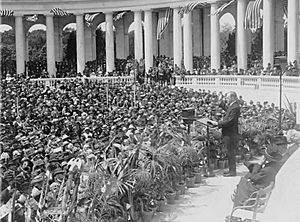
After his presidency, Coolidge retired to a spacious home in Northampton, "The Beeches". He kept a Hacker runabout boat on the Connecticut River and was often observed on the water by local boating enthusiasts. During this period, he also served as chairman of the Non-Partisan Railroad Commission, an entity created by several banks and corporations to survey the country's long-term transportation needs and make recommendations for improvements. He was an honorary president of the American Foundation for the Blind, a director of New York Life Insurance Company, president of the American Antiquarian Society, and a trustee of Amherst College.
Coolidge published his autobiography in 1929 and wrote a syndicated newspaper column, "Calvin Coolidge Says", from 1930 to 1931.
Faced with a Democratic landslide in the 1932 presidential election, some Republicans spoke of rejecting Hoover as their party's nominee, and instead drafting Coolidge to run. Coolidge made it clear that he was not interested in running again, and that he would publicly repudiate any effort to draft him. Hoover was renominated, and Coolidge made several radio addresses in support of him. Hoover then lost the general election to Coolidge's 1920 vice presidential Democratic opponent Franklin D. Roosevelt in a landslide.
Death
Coolidge died suddenly from coronary thrombosis at "The Beeches" on January 5, 1933, at 12:45 p.m., aged 60. Shortly before his death, Coolidge confided to an old friend: "I feel I no longer fit in with these times." Coolidge is buried in Plymouth Notch Cemetery, Plymouth Notch, Vermont. The nearby family home is maintained as one of the original buildings on the Calvin Coolidge Homestead District site. The State of Vermont dedicated a new visitors' center nearby to mark Coolidge's 100th birthday on July 4, 1972.
Radio, film, and commemorations
Despite his reputation as a quiet and even reclusive politician, Coolidge made use of the new medium of radio and made radio history several times while president. He made himself available to reporters, giving 520 press conferences, meeting with reporters more regularly than any president before or since. Coolidge's second inauguration was the first presidential inauguration broadcast on radio. On December 6, 1923, his speech to Congress was broadcast on radio, the first presidential radio address. Coolidge signed the Radio Act of 1927, which assigned regulation of radio to the newly created Federal Radio Commission. On August 11, 1924, Theodore W. Case, using the Phonofilm sound-on-film process he developed for Lee de Forest, filmed Coolidge on the White House lawn, making "Silent Cal" the first president to appear in a sound film. The title of the DeForest film was President Coolidge, Taken on the White House Grounds. When Charles Lindbergh arrived in Washington on a U.S. Navy ship after his celebrated 1927 trans-Atlantic flight, President Coolidge welcomed him back to the U.S. and presented him with the Medal of Honor; the event was captured on film.
Interesting facts about Calvin Coolidge
- Calvin Coolidge was the 30th president of the United States (1923–29).
- He was sworn into office by his own father, John Calvin Coolidge.
- Calvin Coolidge was nicknamed "Silent Cal" because he did not talk much.
- His wife was a teacher at the Clarke Institute for the Deaf. She raised awareness for deaf people and also invited Helen Keller to the White House.
- He was famous for not reinstating officers who had been fired during a strike by Boston police in 1919 saying “There is no right to strike against the public safety by anybody, anywhere, any time.”
- For exercise he rode a mechanical horse in the White House.
- He was the only president born on the 4th of July.
- He was given a raccoon to eat for Thanksgiving dinner in 1926. Being an animal lover he decided to pardon the raccoon and it became a family pet called Rebecca. In 1928 it was given to a zoo.
- Coolidge was the only president to have his portrait on a coin during his lifetime
Images for kids
-
Coolidge's home (1906−1930) in Northampton, Massachusetts
-
President Coolidge signing appropriation bills for the Veterans Bureau on the South Lawn during the garden party for wounded veterans, June 5, 1924. General John J. Pershing is at left. The man at right, looking on, appears to be Veterans Bureau Director Frank T. Hines.
-
Coolidge with his vice president, Charles G. Dawes
-
Coolidge's cabinet in 1924, outside the White House. Front row, left to right: Harry Stewart New, John W. Weeks, Charles Evans Hughes, Coolidge, Andrew Mellon, Harlan F. Stone, Curtis D. Wilbur. Back row, left to right: James J. Davis, Henry C. Wallace, Herbert Hoover, Hubert Work.
-
Coolidge appointed Harlan F. Stone first as Attorney General and then as a Supreme Court Justice.
See also
 In Spanish: Calvin Coolidge para niños
In Spanish: Calvin Coolidge para niños



